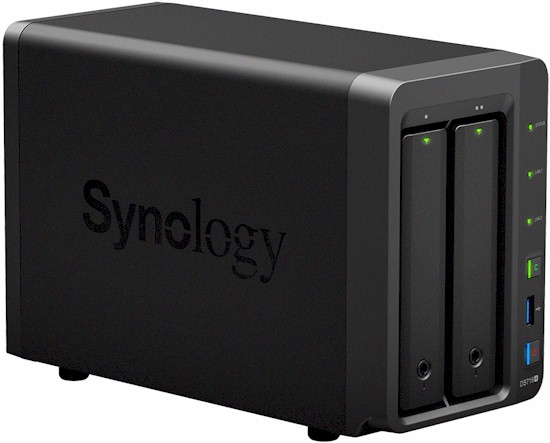
| At a glance | |
|---|---|
| Product | Synology Disk Station (DS716+) [Website] |
| Summary | Two-bay, expandable quad-core Intel Celeron-based NAS with large feature set |
| Pros | • Supports BTRFS • Expandable to 7 bays total with one DX513 cabinet • Broad feature set with lots of installable apps • Btrfs-enabled snapshot backups • 4K video transcoding • Quiet |
| Cons | • Relatively expensive • Expansion option is expensive • Relatively poor large file RAID1 performance • Memory not upgradeable without voiding warranty • More expensive than better performing NASes |
Typical Price: $524 Buy From Amazon
Introduction
Now that 2016 is here, we’re starting to see some of the latest crop of 2016 NASes from Synology. We last reviewed the Synology DS216 2-bay NAS targeted to the value conscious consumer. This review covers Synology’s DS716+ Disk Station.
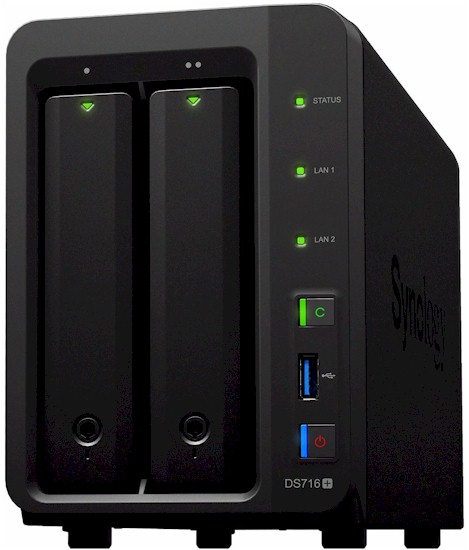
The table below positions the DS716+ in Synology’s small business focused plus series.
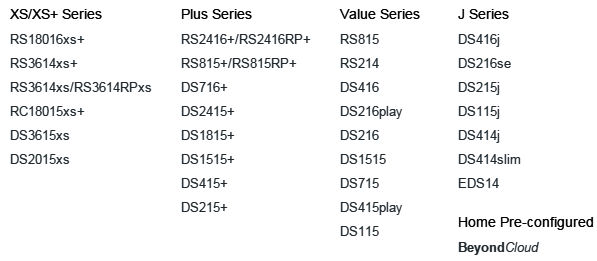
Synology Product Lineup
The DS716+ replaces the DS713+ as Synology’s most expensive two-bay NAS. Like the DS713+, the DS716+ is a two-bay NAS, but expandable to a total of seven bays with addition of the optional eSATA-connected DX513 expansion cabinet.
The DS716+ has its own Quick Installation Guide that includes step-by-step instructions for mounting disks into tool-less disk trays, connecting the DS716+ to power and LAN and configuring the NAS. The Quick Installation Guide also includes front and rear panel callouts, shown below, as well as an LED Indicator Table found in Appendix B.
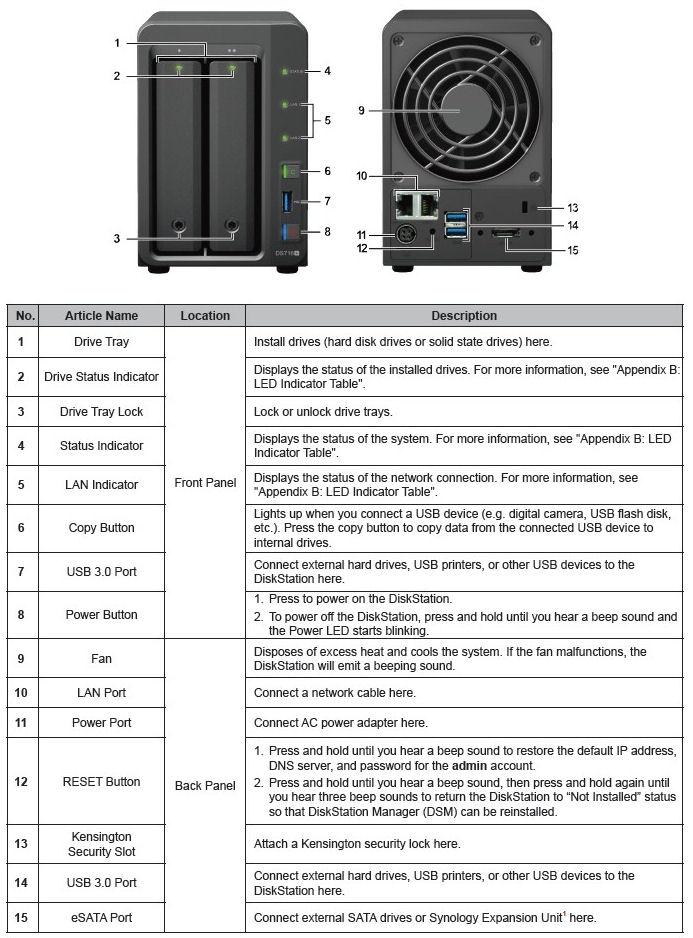
Synology DS716+ front and rear panel callouts
Inside
Unlike the DS713+, the DS716+’s board was difficult to remove. The image below shows the main PCB. There’s a single memory slot containing a 2 GB DDR3 SoDIMM. But there’s a warning seal declaring your warranty void if you remove the memory.
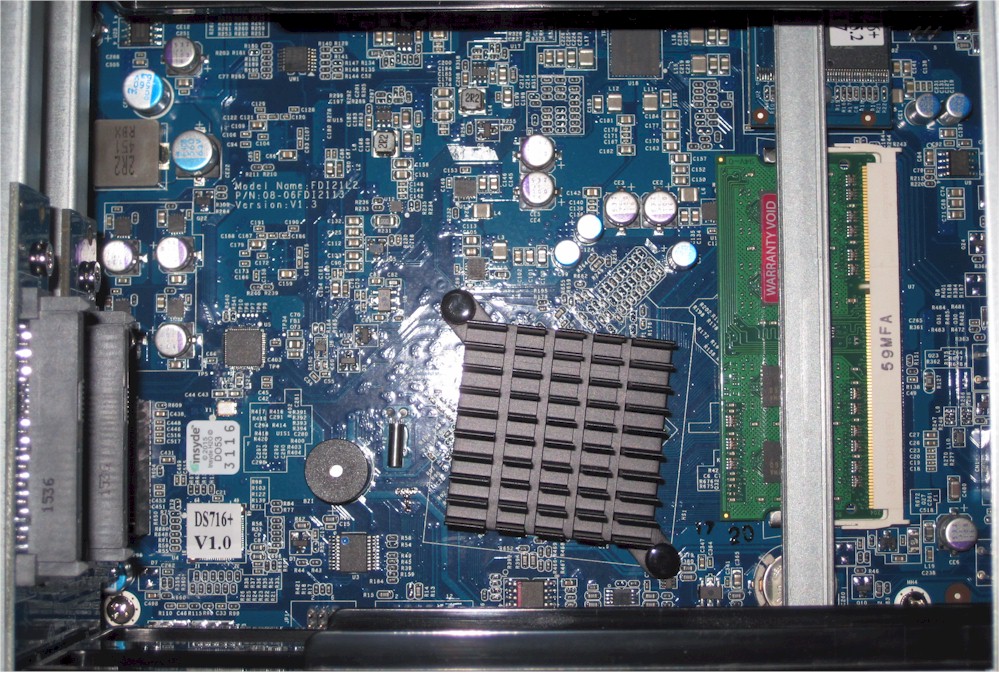
Synology DS716+ main PCB
Compared to the DS713+, the DS716+ features a beefier Intel quad-core Celeron and double the amount of RAM. The table below summarizes the key components of the DS713+, DS716+ and two recently-reviewed similar products from ASUSTOR.
| Synology DS716+ | Synology DS713+ | ASUSTOR AS5102T | ASUSTOR AS6202T | |
|---|---|---|---|---|
| CPU | Intel Celeron N3150 1.6 GHz quad-core | Intel Atom D2700 2.13 GHz dual core | Intel Celeron J1900 2.0 GHz quad-core | Intel Celeron N3150 1.6 GHz quad-core |
| RAM | 2 GB DDR3 in SoDIMM. Upgrade/removal voids warranty | 1 GB DDR3 | 2GB DDR3 Upgradeable to 8GB | 4 GB DDR3 SoDIMM (2 x 2 GB), upgradeable to 8 GB |
| Flash | 128 MB DOM Samsung | 128 MB DOM | ADATA IUM01-001GFHL (128 MB USB DOM) | ADATA IUM01-512MFHL (512 MB USB DOM) |
| Ethernet | Intel WG82574L (x2) | Intel WG82574L (x2) | Broadcom BCM57781 (x2) | Broadcom BCM57781 (x2) |
| USB 3.0 | Etron Tech EJ168A | Etron Tech EJ168A | ASM1074 | In CPU |
| SATA | Marvell 88SE9170-NNX2 | Silicon Image Sil3531 | ASM1061 (x2) | ASM1061 (x2) |
Table 1: Key component summary
The ASUSTOR AS6202T provides the most direct comparison because it uses the same processor. Note, however, the ASUSTOR comes with 4 GB of RAM that’s expandable to 8 GB total. The ASUSTOR, however, doesn’t support an expansion cabinet.
With two drives, the DS716+ drew 19 W with WD Red 1 TB (WD10EFRX) drives spun up and 10 W with the drives spun down for power save. Noise was rated as low. RAID 1 rebuild was immediate when the bad block check option was skipped.![]()
Features
The DS716+ uses the same operating system and has most of the same features as found on all other Synology NASes. Of course, some of the features are hardware dependent and may not be on every model. The current operating system is DSM 5.2.5644 update 2, the version used to test our review unit. When DSM 5.0 was released last year, I wrote a full review of its features.
A list of DSM 5.2’s updated features can be found here and you can download the DSM 5.2 User’s Guide. Unfortunately, the link that used to take you to a live demo of DSM now takes you to a page full of tutorials. Synology tells us the live demo will be back soon, perhaps when DSM 6.0 exits beta.
The image below is the DS716+’ landing page. For illustration purposes, the on-screen widget showing CPU and LAN utilization has been enabled.
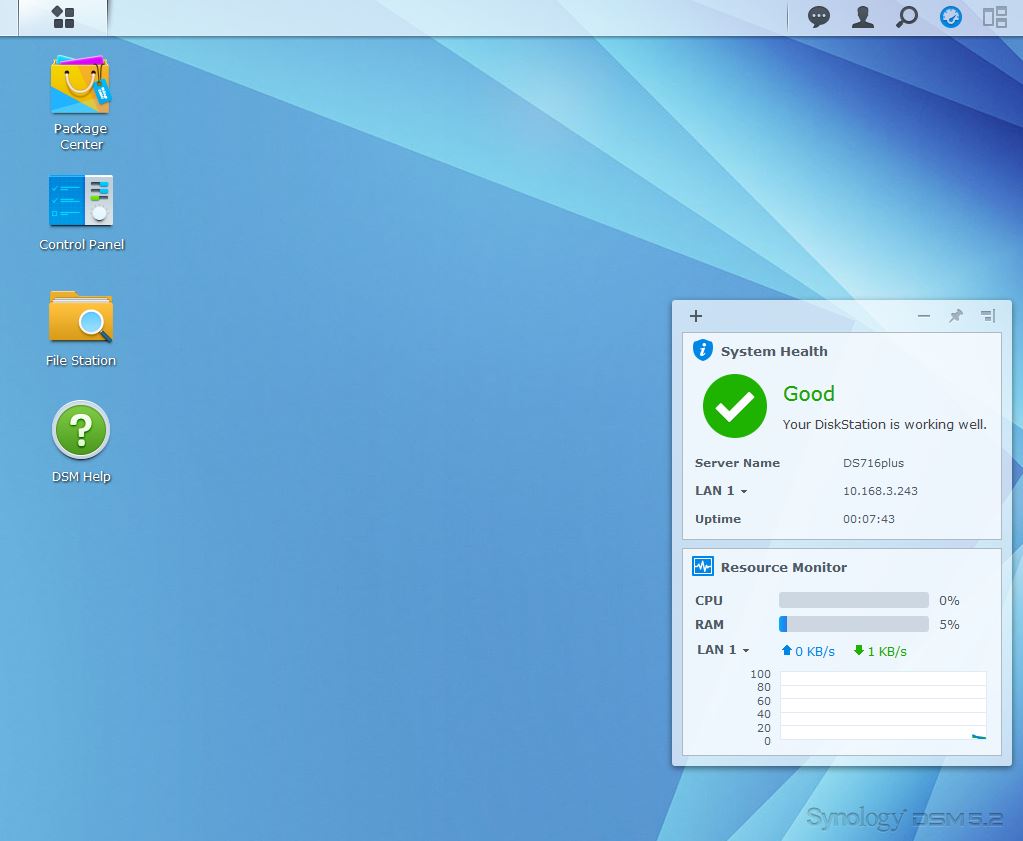
Synology DS716+ landing page
The image below is the Synology Storage Manager. What’s really important about this image is the filesystem.
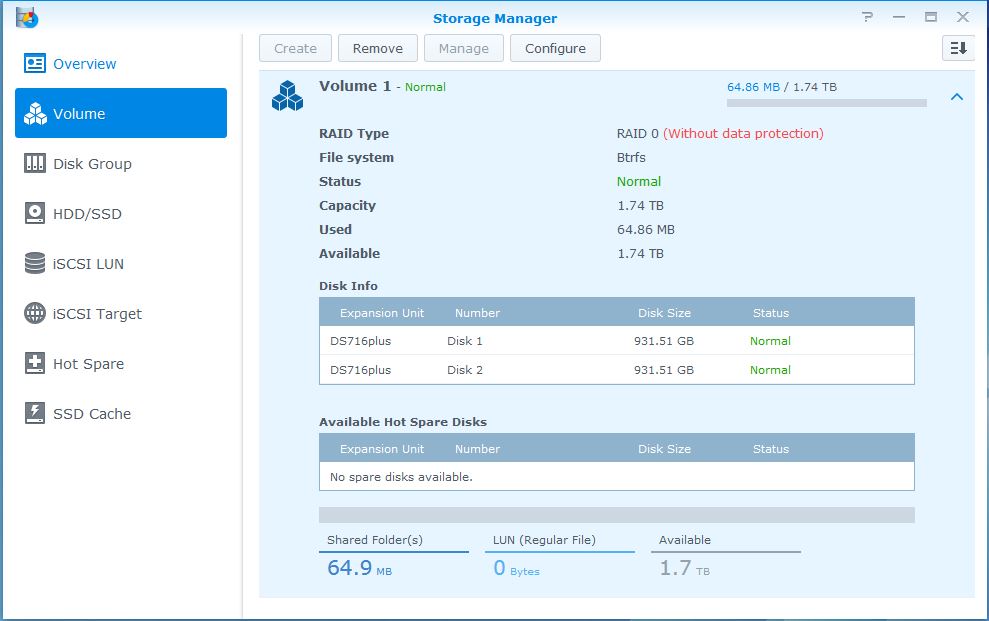
Synology DS716+ Storage Manager
The DS716+ is the first Synology we’ve seen that defaults to the Btrfs filesystem. Most other NASes use the EXT4 filesystem. If you poke around Synology’s site, you’ll find this white paper detailing some of the features and benefits of Btrfs. While Btrfs has been included in Synology’s description of the DSM 6.0 feature set, we were surprised to see it implemented in DSM 5.2 as the default filesystem. Here’s Synology’s bullet point summary of Btrfs.
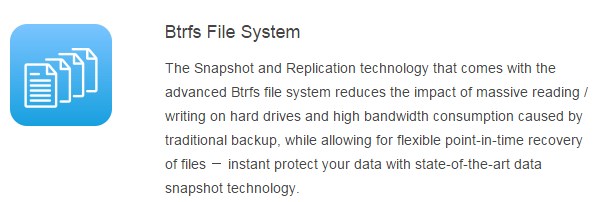
Synology’s brief description of Btrfs
This isn’t my first encounter with Btrfs. That was in June 2013 when I reviewed NETGEAR’s ReadyNAS OS6. The review included a hands-on section detailing my experience with Btrfs snapshots. While the snapshot feature is not part of this review, I’m assuming it works in a similar fashion on the DS716+.
Performance
DSM 5.2-5644 update 2 firmware was loaded onto the DS716+ and performance tests were run using the Revision 5 NAS test process. All tests were run using Western Digital Red 1 TB (WD10EFRX) drives (x2 SNB supplied). We are not including the Synology DS713+ as part of our performance comparisons because it was tested with the previous, Revision 4 NAS test process, and results would not be directly comparable.
The composite image below shows RAID 0 File Copy Write and File Copy Read performance for two drive NASes tested with the Revision 5 test process. For File Copy Write, the DS716+ turned in 107.6 MB/s which was slightly lower than the chart-topping 110.5 MB/s. For File Copy Read performance, the DS716+ was close to the top of the charts at 108.3 MB/s.
Note that quite a few NASes in both charts cluster between 109 and 110 MB/s. That’s about the maximum throughput that you can achieve with single client Gigabit Ethernet testing. And, as Tim has noted in other reviews, performance within 5% of each other is ranked the same. What’s important here is the DS716+ is in the top tier and within the 5% tolerance for both tests.
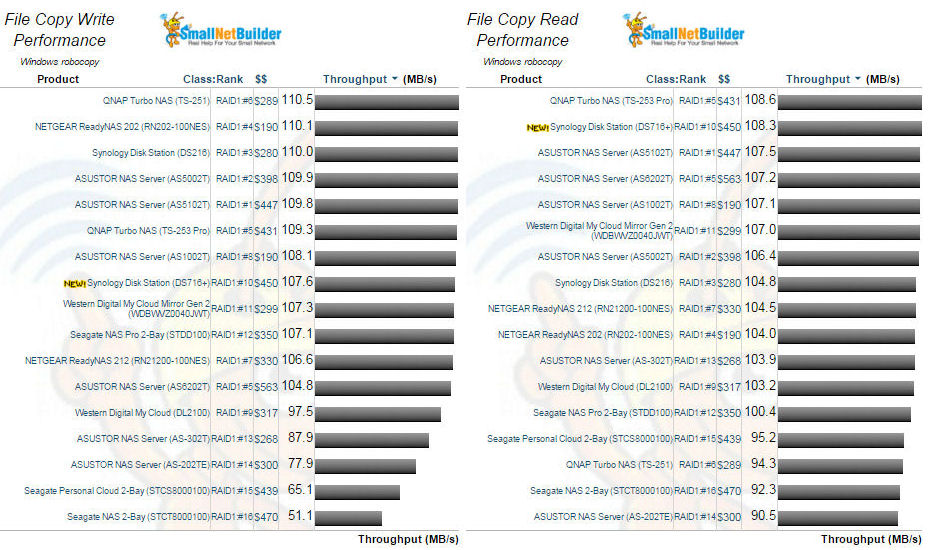
File Copy Write and File Copy Read performance for two drive NASes
For this review, I’ve chosen to compare the DS716+ with two products from ASUSTOR. The AS5102T is priced slightly below the DS716+, and, as shown in the key component summary above, the AS6202T uses the same Braswell Intel Celeron 3150 quad core processor. As noted in the features section of this review, the DS716+ defaults to the Btrfs filesystem. The other two products use EXT4.
The benchmark summaries below show individual test results for each of the three selected products. For all three products, the RAID 0 File Copy Write and Read benchmarks were all within a couple of percentage points of each other and near the maximum throughput of a single Gigabit Ethernet client. However, for RAID 1, the Synology DS716+ File Copy Write (74.3 MB/s) and Read (92/3 MB/s) performance was significantly below the other two products, which each turned in scores well above 100 MB/s on both File Copy Write and Read tests.
While all three products also had similar scores for the NASPT File Copy to NAS and NASPT File Copy from NAS for RAID 0, the DS716+ again had significantly poorer performance than the other two products on both NASPT File Copy tests for RAID 1. The differences in RAID 1 File Copy performance, both for Windows File copy as well as NASPT File are so significant – especially for write operations, that I’ve highlighted the four tests in red.
The DS716+ lacks USB 2.0 ports, so USB Backup results were reported for only for USB 3.0 for all three supported file types. Both of the ASUSTOR NASes have USB 2.0 and USB 3.0 ports so results were reported for both interfaces. For USB 3.0 Backup, the DS716+ had the slowest throughput for all three supported file formats. Similarly, for eSATA backup, the DS716+ trailed both ASUSTOR NASes for all formats except for NTFS, where it tied with the AS6202T at 106.3 MB/s. At 52.5 MB/s, the DS716+ also trailed both of the other NASes for network backup. For iSCSI, the AS5102T outperformed both of the other NASes by a significant amount for both write and read operations.
Note: The iSCSI tests were run with the DS716+ configured for RAID1 using the default Btrfs file system.
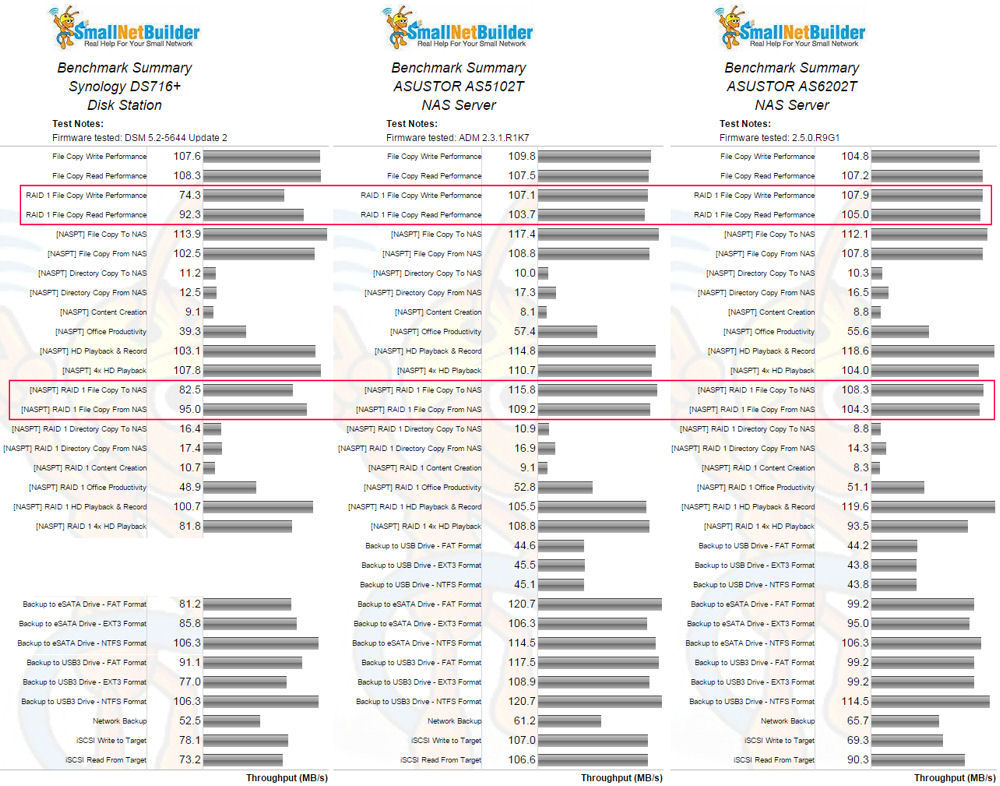
Benchmark summary comparison
Because of the unexpected variances in performance, we re-ran the benchmark tests using the EXT4 file format for both RAID 0 and RAID 1. The table below summarizes those results. The first column of data reflects the performance data that appears in the benchmark summary charts for the DS716+ using the default Btrfs file system. The second column shows the same test results using the EXT4 format. The third column shows the percent difference compared to the default Btrfs results.
| Btrfs (MB/s) | EXT4 (MB/s) | % Difference | Encrypt Btrfs (MB/s) | %Difference | |
|---|---|---|---|---|---|
| File Copy Write Performance | 107.6 | 106.0 | -1.5% | ||
| File Copy Read Performance | 108.3 | 102.8 | -5.1% | ||
| RAID 1 File Copy Write Performance | 74.3 | 93.7 | 26.0% | 58.1 | -21.8% |
| RAID 1 File Copy Read Performance | 92.3 | 91.5 | -0.8% | 101.04 | 9.5% |
| [NASPT] File Copy To NAS | 113.9 | 116.3 | 2.1% | ||
| [NASPT] File Copy From NAS | 102.5 | 106.5 | 3.9% | ||
| [NASPT] Directory Copy To NAS | 11.2 | 13.5 | 20.4% | ||
| [NASPT] Directory Copy From NAS | 12.5 | 17.2 | 37.8% | ||
| [NASPT] Content Creation | 9.1 | 12.3 | 34.7% | ||
| [NASPT] Office Productivity | 39.3 | 55.0 | 40.0% | ||
| [NASPT] HD Playback & Record | 103.1 | 111.7 | 8.3% | ||
| [NASPT] 4x HD Playback | 107.8 | 106.6 | -1.1% | ||
| [NASPT] RAID 1 File Copy To NAS | 82.5 | 89.4 | 8.3% | 41.29 | -50.0% |
| [NASPT] RAID 1 File Copy From NAS | 95.0 | 100.2 | 5.4% | 98.76 | 3.9% |
| [NASPT] RAID 1 Directory Copy To NAS | 16.4 | 17.2 | 4.9% | 6.87 | -58.0% |
| [NASPT] RAID 1 Directory Copy From NAS | 17.4 | 17.5 | 0.4% | 14.88 | -14.4% |
| [NASPT] RAID 1 Content Creation | 10.7 | 10.0 | -5.8% | 6.1 | -42.8% |
| [NASPT] RAID 1 Office Productivity | 48.9 | 48.4 | -1.1% | 42.73 | -12.6% |
| [NASPT] RAID 1 HD Playback & Record | 100.7 | 88.8 | -11.8% | 88.94 | -11.7% |
| [NASPT] RAID 1 4x HD Playback | 81.8 | 79.3 | -3.1% | 98.48 | 20.4% |
Table 1: Benchmark comparisons between Btrfs and EXT4 file systems
For Windows File copy write and read operations, Btrfs performance was slightly better for RAID 0. Looking at the RAID 1 Windows file copy performance, for write operations, EXT4 was 26% faster than Btrfs. For RAID 1 file copy read, the filesystem didn’t seem to have much of an impact as there was less than 1% difference between those results. But if you compare RAID 0 results to RAID 1 results there’s a big difference between the two with RAID 1 being significantly slower than RAID 0 for either filesystem. You have similar results for the RAID 0 and RAID 1 NASPT File Copy To NAS and File Copy From NAS results. There’s under a 10% difference between performance on those tests within the RAID type being tested, but lower performance for RAID 1 than RAID 0 on corresponding tests.
Interestingly, there were some tests in which the file system did seem to have a big impact. The largest differences were observed for NASPT Directory Copy to NAS (20.4%), NASPT Directory Copy from NAS (37.8%), NASPT Content Creation (34.7%) and NASPT Office Productivity (40%). Significantly smaller percent differences were observed for the corresponding tests for RAID 1.
We also ran tests using an encrypted folder on a Btrfs / RAID 1 volume. Those results, and the corresponding percent difference are show in columns four and five.
Performance – more
The composite NAS Ranker chart below was filtered for RAID 1 and Revision 5 testing and sorted by descending price. The DS716+ at $450 is a relative bargain vs. the ASUSTOR AS6202T, which uses the same processor. But the Synology significantly trails the ASUSTOR in rank at #10 vs. #5. The top-ranked ASUSTOR AS5102T is a relative bargain at $428.
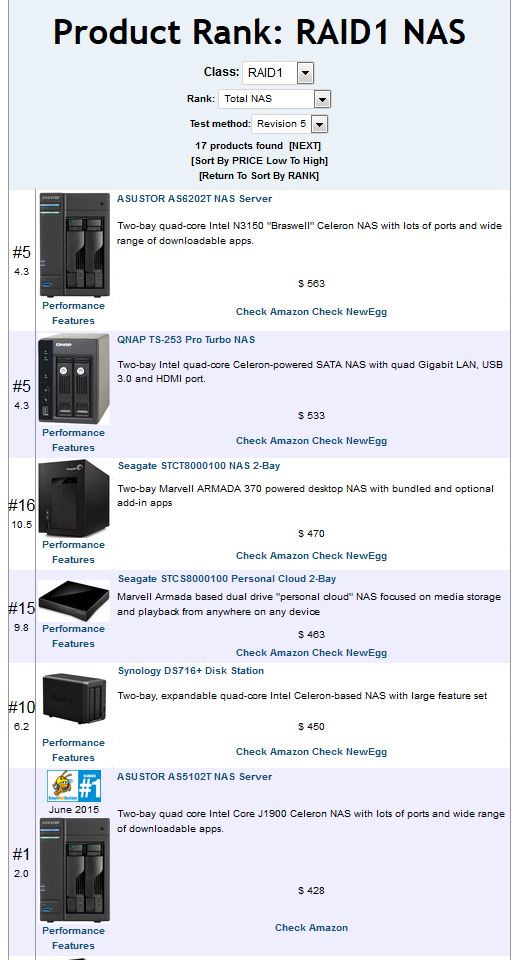
RAID 1 NAS Rank – Descending price sort
The chart below shows the individual and category scores for the same three NASes used in the benchmark summary above. The Synology DS716+ didn’t win any of test categories and ended up with a #10 Total NAS ranking. With two NASes tied for #5, that’s effective eleventh out of 17 NASes. Its best showing was a tie for #7 with the ASUSTOR AS6202T for iSCSI performance..
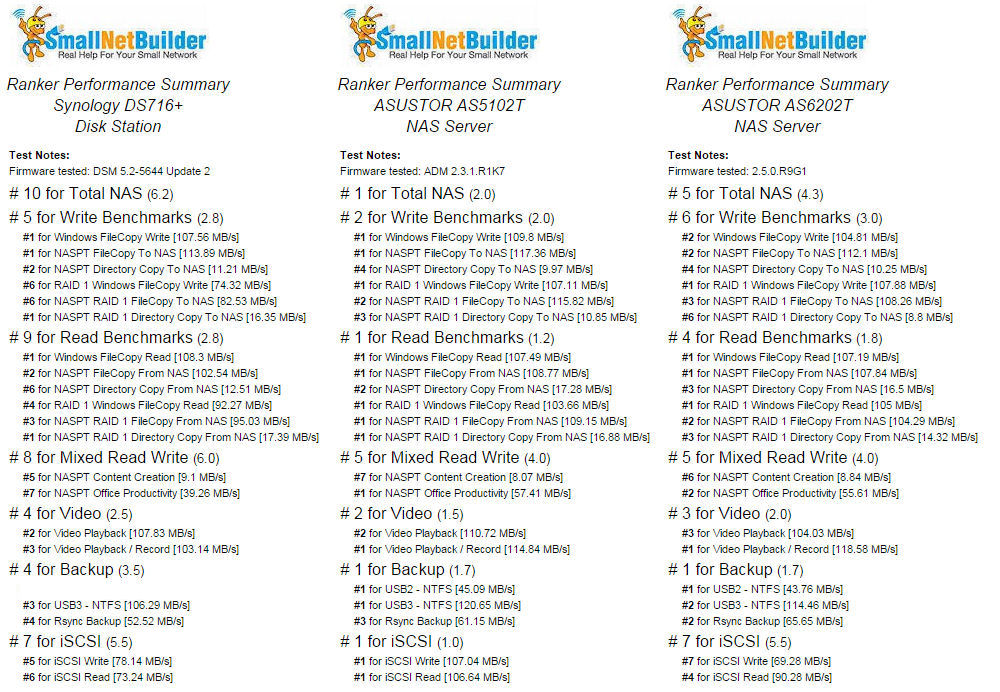
Ranker Performance Summary comparison
Closing Thoughts
With a street price of about $450, the Synology DS716+ is one of the most expensive two-bay NASes you can purchase. The only models that cost more are the #1 ranked $468 ASUSTOR 5102T (included for comparison in this review), the #16 ranked $470 Seagate STCT8000100 NAS and the #5 ranked $563 ASUSTOR AS6202T (also included for comparison in this review). Note: the pricing on the ASUSTOR AS5102T seems to be bouncing around a little bit. Earlier last week, it was selling for $438 making it both the top ranked two-bay NAS as well as cheaper than the DS716+.
From a performance perspective, the DS716+ was a disappointment. Relatively low RAID 1 performance for File Copy Read and Write tests as well as slower backup hurt the overall Total NAS ranking. If you sort the NAS ranker by price, you notice that there are nine NASes with a better (lower) Total NAS score that are also cheaper than the DS716+ including the #3 ranked Synology DS216.
The DS716+ is expandable to seven bays with the addition of the DX513, but the expansion chassis, currently at $526, is pretty expensive. The DS716+ does support the Btrfs filesystem that provides added fault tolerance and nearly instantaneous data snapshots. But looking at some of the performance differences between Btfrs and EXT4, I’d have to weigh the impact on actual use before I’d trade performance for additional fault tolerance. Perhaps Synology will address some of the performance issues noted in this review and bring the DS716+ in line with the performance with the ASUSTOR NASes with a future firmware update.
For now, the ASUSTOR AS5102T keeps its #1 ranking based on performance, and the $299 Western Digital My Cloud Gen 2 (with two TB disks included) remains the best overall storage value for a two-bay NAS.![]()
